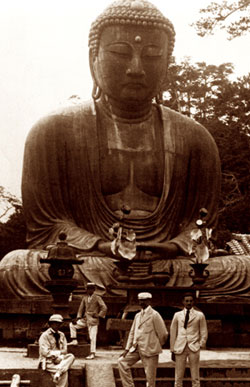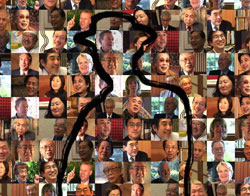Magnificent Obsession is the result of our own burgeoning obsession with Frank Lloyd Wright, which began during a protracted—but ultimately successful—campaign to save Wright's last public building in Tokyo, the Jiyu Gakuen Myonichikan.
 That campaign inspired us to look a little deeper. The surface details were interesting enough: Wright designed a dozen or so buildings for Japan, the only country outside America in which he had lived, and influenced a generation of Japanese followers. But just below the surface, we found a dramatic tale of disgrace and redemption, with Japan acting as the catalyst for Wright's eventual return to favor. The construction of the Imperial Hotel had not only shored up a wobbly career, it had engendered lasting relationships that spanned thousands of miles, nearly four decades and one world war, when Wright and his friends were suddenly on opposite sides of the conflict.
That campaign inspired us to look a little deeper. The surface details were interesting enough: Wright designed a dozen or so buildings for Japan, the only country outside America in which he had lived, and influenced a generation of Japanese followers. But just below the surface, we found a dramatic tale of disgrace and redemption, with Japan acting as the catalyst for Wright's eventual return to favor. The construction of the Imperial Hotel had not only shored up a wobbly career, it had engendered lasting relationships that spanned thousands of miles, nearly four decades and one world war, when Wright and his friends were suddenly on opposite sides of the conflict.
During preproduction in 2001 for a feature film on the great architect’s Japan experience, we realized that Wright's legacy was being eroded by the loss of those with firsthand knowledge in Japan, and by the nation’s casual destruction of historic documents and artifacts. We started taking our camera with us to record reminiscences, to capture fading photo albums and to catch the light glancing off scratch tiles and handtooled eaves.
By early 2002, we knew that the feature film had to be put on hold while we first assembled footage for a long-overdue documentary on Wright’s 70-year relationship with the nation he loved next to his own. We wanted to pay tribute to all the Japanese architects who had kept his spirit alive but were never recognized for their own contributions to organic architecture.
 Japanese documentarians were aghast that we had neither a TV contract, outside funding nor a Hi-Def package. But time was of the essence: many of our interviewees were in their twilight years and anxious to share their stories with the world (already, five of them are no longer with us). We eventually interviewed close to 100 architects, historians and descendents of Wright’s Japanese colleagues, visited several dozen buildings scattered around Japan, and ransacked archival files on three continents in our search for missing details.
Japanese documentarians were aghast that we had neither a TV contract, outside funding nor a Hi-Def package. But time was of the essence: many of our interviewees were in their twilight years and anxious to share their stories with the world (already, five of them are no longer with us). We eventually interviewed close to 100 architects, historians and descendents of Wright’s Japanese colleagues, visited several dozen buildings scattered around Japan, and ransacked archival files on three continents in our search for missing details.
Ultimately, the documentary became the first comprehensive overview of Wright's time in and imprint on Japan. But even at 126 minutes, it was far from complete. So we took steps in 2005 to ensure that new revelations could someday emerge. By establishing the nonprofit Wrightian Architectural Archives Japan, our hope is that greater cross-border research will lead to a fuller picture of Wright’s legacy in Japan, even as the organization works to protect the nation’s constantly endangered built heritage.
 That campaign inspired us to look a little deeper. The surface details were interesting enough: Wright designed a dozen or so buildings for Japan, the only country outside America in which he had lived, and influenced a generation of Japanese followers. But just below the surface, we found a dramatic tale of disgrace and redemption, with Japan acting as the catalyst for Wright's eventual return to favor. The construction of the Imperial Hotel had not only shored up a wobbly career, it had engendered lasting relationships that spanned thousands of miles, nearly four decades and one world war, when Wright and his friends were suddenly on opposite sides of the conflict.
That campaign inspired us to look a little deeper. The surface details were interesting enough: Wright designed a dozen or so buildings for Japan, the only country outside America in which he had lived, and influenced a generation of Japanese followers. But just below the surface, we found a dramatic tale of disgrace and redemption, with Japan acting as the catalyst for Wright's eventual return to favor. The construction of the Imperial Hotel had not only shored up a wobbly career, it had engendered lasting relationships that spanned thousands of miles, nearly four decades and one world war, when Wright and his friends were suddenly on opposite sides of the conflict. During preproduction in 2001 for a feature film on the great architect’s Japan experience, we realized that Wright's legacy was being eroded by the loss of those with firsthand knowledge in Japan, and by the nation’s casual destruction of historic documents and artifacts. We started taking our camera with us to record reminiscences, to capture fading photo albums and to catch the light glancing off scratch tiles and handtooled eaves.
By early 2002, we knew that the feature film had to be put on hold while we first assembled footage for a long-overdue documentary on Wright’s 70-year relationship with the nation he loved next to his own. We wanted to pay tribute to all the Japanese architects who had kept his spirit alive but were never recognized for their own contributions to organic architecture.
 Japanese documentarians were aghast that we had neither a TV contract, outside funding nor a Hi-Def package. But time was of the essence: many of our interviewees were in their twilight years and anxious to share their stories with the world (already, five of them are no longer with us). We eventually interviewed close to 100 architects, historians and descendents of Wright’s Japanese colleagues, visited several dozen buildings scattered around Japan, and ransacked archival files on three continents in our search for missing details.
Japanese documentarians were aghast that we had neither a TV contract, outside funding nor a Hi-Def package. But time was of the essence: many of our interviewees were in their twilight years and anxious to share their stories with the world (already, five of them are no longer with us). We eventually interviewed close to 100 architects, historians and descendents of Wright’s Japanese colleagues, visited several dozen buildings scattered around Japan, and ransacked archival files on three continents in our search for missing details.Ultimately, the documentary became the first comprehensive overview of Wright's time in and imprint on Japan. But even at 126 minutes, it was far from complete. So we took steps in 2005 to ensure that new revelations could someday emerge. By establishing the nonprofit Wrightian Architectural Archives Japan, our hope is that greater cross-border research will lead to a fuller picture of Wright’s legacy in Japan, even as the organization works to protect the nation’s constantly endangered built heritage.

